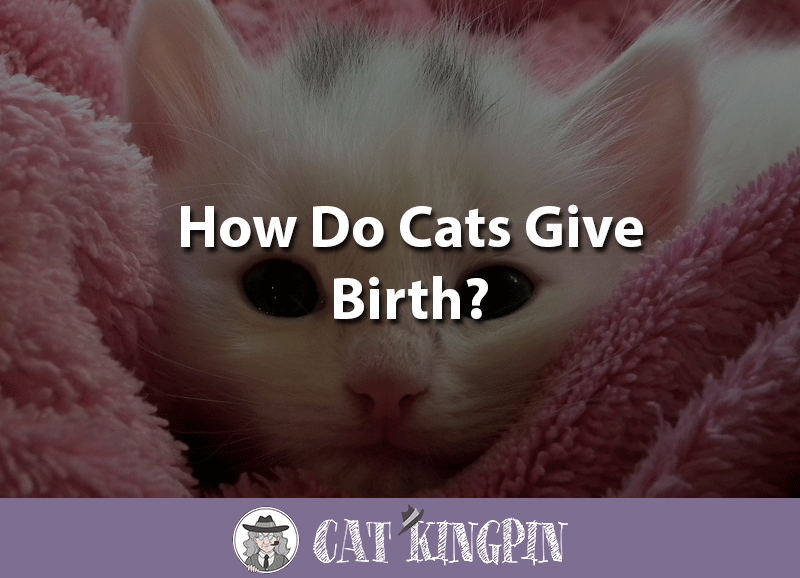How Do Cats Give Birth?
Think your cat is ready to give birth? Want to know more about the process?
Queening is the term that describes the time at which your pregnant cat will begin the process of labour and delivery. During this time, you can expect various physiological changes occurring in your queen (your female cat) such as an increase in weight (20-25%), a change in temperature and changes in behavior.
In this article we’ll cover the following:
- When Do Cats Give Birth?
- Where Do Cats Like To Give Birth
- What Happens During This Process?
- What Can You Do To Help?
When Do Cats Give Birth?
“Kitten season” often refers to the time in which an unspayed cat may be ready to bare her new litter of kittens. The time of a queening is thus likely to occur during early to late spring and end carry onto the end of autumn.
Where Do Cats Like To Give Birth?
Queens prefer to give to birth in a place that will be safe for her kittens, a place where she will have easy access to them. These places can be small, dark area away from predators.
During the last few days of her gestation period she may start wandering in search of a quiet place.
What Happens During This Process?
Queen’s have a gestation period of 62 to 67 days where the average is 64 days. The labor and birthing process can be broken down into 3 stages. During the first stage, you will notice your queen looking a little more anxious of-sort.
The first stage is when her cervix will dilate, her abdomen distends ventrally and she may be restless. When you notice your queen looking for a place to rest, make sure she knows where her delivery box is. This stage can last anywhere from 12 to 24 hours.
This is where things get exciting as during stage 2 the kitten(s) make their way into her pelvic canal. It may take a while for the first kitten to come out, however once born the rest of the kitten’s come within 15 to 20 minutes of each other.
During the second stage, you will notice that your queen’s abdomen will contract 3 to 5 times every few minutes after each kitten. The amniotic fluid will be released and you will notice either the head or back end of the kitten pop-out! This is normal.
This ties into the final stage of parturition, which is the third stage, the expulsion of the placenta. Each kitten is encased in placenta and often the queens will eat this placenta right after the kitten is born.
Some suggest that this may be an evolutionary act as eating placenta “hide’s traces” of her kitten thus protecting them from predators. Whilst others say this is for nutritional benefits. A queen should not have too much as this can lead to diarrhea.
During this time your queen may go for a drink of water or consume small amounts of food and may be particularly more interested in softer food. This is all normal! It is only a concern when the queen does not eat or seems depressed
Bare in mind these are graphic videos and should not be watched if you feel queasy.
I’ve posted this interesting video of a lovely cat giving birth, notice how she constantly licks her perineal area, her kittens, and abdomen.
In the second video, you can see how the queen eats the placenta and umbilical cord.
It’s also interesting to know that kittens from the same litter can have different fathers.
What Can You Do To Help?
If you have a queen who may be ready to give birth then make sure you offer her an easy access box which can be warmed with old towels. Most queens will seek a comfortable, quiet area which will offer protection to their newborns. No diapers necessary!
Before she goes into labor (a few days before), make sure you get your supplies ready! Firstly, if possible keep her abdomen region clean and shaved, this will allow her kittens easy access to the nipples.
You should also get her checked up by a veterinarian when you know her due date is near. If you are experienced with the process of feline parturition then using a thermometer (do not use glass ones, use a pet one) take her rectal temperature; It should be between 39 to 39C.
Always keep your veterinarian’s phone number in hand, fresh towels, iodine solution, hemostats and blunt-ended scissors (used to cut umbilical cord should this be necessary), a few pairs of sterile surgical gloves and a weighing scale.
When these kittens are born the first thing they will need and will try to get is their mother’s milk. The mother’s first milk is referred to as colostrum and It is essential that all kittens consume colostrum as it is filled with maternal antibodies which will build up a kitten’s immune system.
So, How Do Cats Give Birth?
It’s a simple process that occurs in 3 stages; for the most part your queen may not require any assistance during birthing but it’s best to just keep your veterinarian’s number in hand.
Remember, if this is your first time helping your cat give birth then ask your veterinarian for supplies and help.
Got a queen who’s given birth? Have any more questions? Share them in the comment below.






